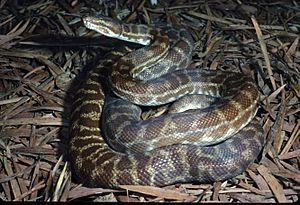Stimson's python facts for kids
Stimson's python (Antaresia stimsoni) is a type of python, which is a snake belonging to the family Pythonidae. This snake is found only in Australia. Stimson's pythons are sometimes kept as pets in certain Australian states.
Quick facts for kids Stimson's python |
|
|---|---|
 |
|
| Conservation status | |
| Scientific classification | |
| Genus: |
Antaresia
|
| Species: |
stimsoni
|
| Synonyms | |
|
|
Contents
About Stimson's Python
The Stimson's python was first described in 1985 by a scientist named Lawrence Alec Smith. Both the snake's scientific name, stimsoni, and its common name, Stimson's python, honor a snake expert named Andrew Francis Stimson. He worked at the Natural History Museum in London.
Sometimes, people mistakenly call this snake "Stimpson's python." It also has other names like the large-blotched python, because of the patterns on its skin. Another name is the inland children's python, which refers to the group of snakes it belongs to.
What Stimson's Pythons Look Like
Stimson's pythons are part of the Pythonidae family. These snakes are not venomous. Instead, they catch their prey and squeeze it until it can't breathe.
These pythons are small and live on the ground. Adult snakes can grow to be about 110 centimeters (about 3.6 feet) long. They have special scales that help scientists identify them. These include scales along their back, belly, and under their tail.
Where Stimson's Pythons Live
This snake lives in Australia. You can find it from the coast of Western Australia all the way through the central parts of most states. However, it does not live in the far north, extreme south, or eastern coastal areas.
Stimson's pythons mostly live in dry, inland places. They prefer rocky areas but can also be found in woodlands, dry shrublands, and deserts. It's unusual to find them in wide-open, flat areas. They also live on Dirk Hartog Island.
How Stimson's Pythons Behave
Stimson's pythons are usually active at night. They like to hide in cracks in rocks, hollow logs, or holes made by other animals, like in termite mounds. Termite mounds are good because they help keep the temperature steady.
This snake is an ambush predator. This means it waits quietly for its prey to come close. Once prey is near, the python quickly catches it and squeezes it. They are often found in rocky hills or other places that offer good hiding spots.
What Stimson's Pythons Eat
Stimson's pythons eat small lizards, frogs, and small mammals. Like many other snakes, they can go without food for several months if needed.
Reproduction and Life Cycle
Stimson's pythons lay eggs. Females usually lay a clutch of 7 to 10 eggs. After laying her eggs, the female python wraps her body around them. She stays there to keep them warm until they hatch. She only leaves to warm herself in the sun or when the babies are born.
Stimson's Pythons as Pets
People sometimes keep Stimson's pythons as pets, and they can be successfully bred in captivity. They are generally easy to handle and rarely bite. In Western Australia, they are considered easy to care for and are not rare or endangered.
In 2009, four baby Stimson's pythons escaped on a Qantas airplane. This caused the plane to be fumigated, which means it was cleaned with special chemicals to get rid of them.
If you keep a Stimson's python as a pet, it needs a warm and slightly damp home. You might need to lightly spray its tank with water about once every two weeks. Bedding made of aspen or wood shavings works well for these snakes.
Images for kids



